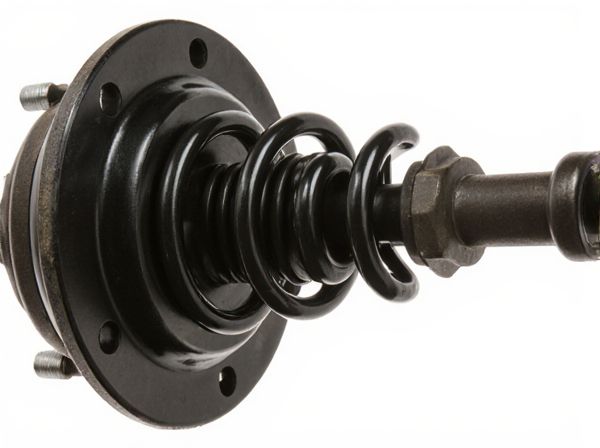
Photo illustration: Torsion Axle vs Leaf Spring Axle
Torsion axles provide a smoother, more independent suspension system by using rubber cords inside the axle housing to absorb shocks, resulting in better ride comfort and less maintenance. Leaf spring axles rely on stacked metal springs that offer durability and simpler construction, making them ideal for heavy loads and rough terrain. Choosing the right axle depends on your vehicle's use, with torsion axles favoring comfort and leaf spring axles prioritizing strength and simplicity.
Table of Comparison
| Feature | Torsion Axle | Leaf Spring Axle |
|---|---|---|
| Suspension Type | Rubber torsion suspension | Multiple layered steel leaf springs |
| Ride Comfort | Smoother, absorbs shocks well | Stiffer, less shock absorption |
| Weight | Lighter design, reduces overall vehicle weight | Heavier due to steel components |
| Maintenance | Low, sealed system with minimal upkeep | Higher, requires regular inspections and lubrication |
| Durability | Resistant to rust, long lifespan | Susceptible to corrosion and wear over time |
| Load Capacity | Typically lower, suitable for light to medium loads | Higher load capacity, ideal for heavy-duty applications |
| Installation | Compact, easier installation on modern vehicles | Bulkier, traditional mounting methods |
| Cost | Generally higher initial cost | Lower upfront cost |
Introduction to Torsion and Leaf Spring Axles
Torsion axles use rubber cords inside a steel housing to provide independent suspension and absorb road shocks, offering a smoother ride and reduced maintenance compared to traditional suspensions. Leaf spring axles consist of stacked, curved metal plates that flex under load to support weight and absorb impacts, making them durable and cost-effective for heavy-duty applications. The choice between torsion and leaf spring axles depends on factors such as ride quality, load capacity, maintenance needs, and vehicle type.
How Torsion Axles Work
Torsion axles use rubber cords inside the axle housing to provide independent suspension by flexing and absorbing road shocks, resulting in a smoother, more controlled ride. Unlike leaf spring axles that rely on stacked metal springs for support and shock absorption, torsion axles offer more precise handling with less maintenance and corrosion risk. This design enhances trailer stability and reduces wear on tires by evenly distributing weight through the torsion arm.
How Leaf Spring Axles Work
Leaf spring axles operate by using a series of curved, flexible steel strips stacked together to absorb shocks and maintain stability in a vehicle's suspension system. The layered springs flex under load, distributing weight evenly across the axle and providing durability and load-carrying capacity ideal for heavy-duty trailers and trucks. Their mechanical simplicity and long lifespan make leaf spring axles a reliable choice for managing rough terrain and heavy payloads compared to torsion axles.
Ride Quality Comparison
Torsion axles provide superior ride quality by using rubber cords inside the axle housing for independent suspension, resulting in smoother shock absorption and reduced vibration compared to leaf spring axles. Leaf spring axles rely on stacked metal plates that offer a firmer, less flexible ride, which can transmit more road bumps and jolts to the vehicle. Vehicles with torsion axles benefit from enhanced comfort on uneven terrain, increased durability, and lower maintenance demands due to fewer moving parts.
Load Capacity and Weight Distribution
Torsion axles provide a consistent load capacity with independent suspension, allowing better weight distribution across the trailer, which enhances ride smoothness and reduces stress on the frame. Leaf spring axles offer higher load capacities in heavy-duty applications but distribute weight less evenly, potentially leading to increased wear on tires and suspension components. Choosing between torsion and leaf spring axles depends on the specific load requirements and the desired balance between weight capacity and suspension performance.
Durability and Maintenance Requirements
Torsion axles offer superior durability due to their rubber torsion arms that absorb shocks and reduce wear, requiring minimal maintenance compared to traditional leaf spring axles. Leaf spring axles rely on multiple leaves that can wear out or break under heavy loads, necessitating regular inspection, lubrication, and occasional replacement to maintain optimal performance. Overall, torsion axles provide a longer lifespan and lower maintenance costs, making them ideal for users seeking durability and ease of upkeep.
Installation and Retrofitting Differences
Torsion axles feature a compact independent suspension system that simplifies installation and retrofitting by requiring less space and fewer alignment adjustments compared to traditional leaf spring axles. Leaf spring axles demand precise shackle and U-bolt placement during installation, making retrofitting more labor-intensive and often necessitating frame modifications. The torsion axle's self-contained rubber cords reduce maintenance and streamline replacement, while leaf spring setups typically involve complex component swaps and potential ride height adjustments.
Cost and Budget Considerations
Torsion axles typically have a higher upfront cost due to advanced rubber suspension components but offer lower long-term maintenance expenses compared to leaf spring axles. Leaf spring axles are generally more affordable initially, making them suitable for tight budgets, though they may incur higher wear-related costs over time. Budget considerations should weigh initial purchase price against durability and maintenance requirements when choosing between torsion and leaf spring axles.
Best Applications for Torsion vs. Leaf Spring Axles
Torsion axles provide a smoother ride and are best suited for lightweight trailers, including small utility, boat, and camper trailers, where independent suspension improves handling and reduces maintenance. Leaf spring axles excel in heavy-duty applications such as commercial trucks, agricultural equipment, and large cargo trailers due to their durability and capacity to handle higher loads and rough terrains. Choosing between torsion and leaf spring axles depends on the trailer's weight, intended use, and required suspension performance.
Conclusion: Choosing the Right Axle for Your Needs
Selecting the right axle depends on your trailer's load capacity, ride quality preferences, and maintenance requirements. Torsion axles offer smoother rides and lower maintenance with independent rubber suspension, ideal for light to medium loads. Leaf spring axles provide durability and cost-effectiveness, making them suitable for heavier loads and rougher terrain.
 caratoz.com
caratoz.com